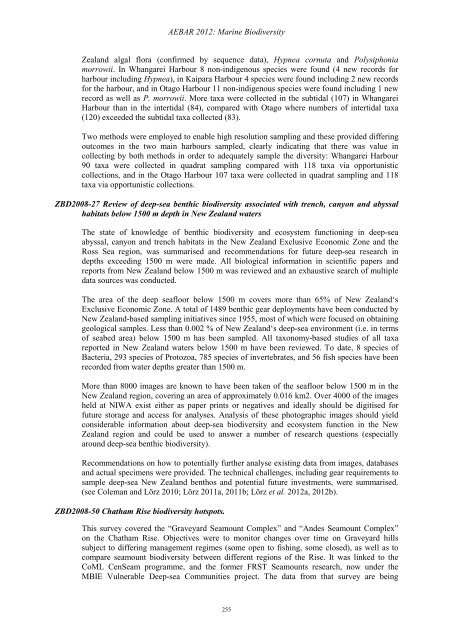Aquatic Environment and Biodiversity Annual Review 2012
Aquatic Environment and Biodiversity Annual Review 2012
Aquatic Environment and Biodiversity Annual Review 2012
Create successful ePaper yourself
Turn your PDF publications into a flip-book with our unique Google optimized e-Paper software.
AEBAR <strong>2012</strong>: Marine <strong>Biodiversity</strong><br />
Zeal<strong>and</strong> algal flora (confirmed by sequence data), Hypnea cornuta <strong>and</strong> Polysiphonia<br />
morrowii. In Whangarei Harbour 8 non-indigenous species were found (4 new records for<br />
harbour including Hypnea), in Kaipara Harbour 4 species were found including 2 new records<br />
for the harbour, <strong>and</strong> in Otago Harbour 11 non-indigenous species were found including 1 new<br />
record as well as P. morrowii. More taxa were collected in the subtidal (107) in Whangarei<br />
Harbour than in the intertidal (84), compared with Otago where numbers of intertidal taxa<br />
(120) exceeded the subtidal taxa collected (83).<br />
Two methods were employed to enable high resolution sampling <strong>and</strong> these provided differing<br />
outcomes in the two main harbours sampled, clearly indicating that there was value in<br />
collecting by both methods in order to adequately sample the diversity: Whangarei Harbour<br />
90 taxa were collected in quadrat sampling compared with 118 taxa via opportunistic<br />
collections, <strong>and</strong> in the Otago Harbour 107 taxa were collected in quadrat sampling <strong>and</strong> 118<br />
taxa via opportunistic collections.<br />
ZBD2008-27 <strong>Review</strong> of deep-sea benthic biodiversity associated with trench, canyon <strong>and</strong> abyssal<br />
habitats below 1500 m depth in New Zeal<strong>and</strong> waters<br />
The state of knowledge of benthic biodiversity <strong>and</strong> ecosystem functioning in deep-sea<br />
abyssal, canyon <strong>and</strong> trench habitats in the New Zeal<strong>and</strong> Exclusive Economic Zone <strong>and</strong> the<br />
Ross Sea region, was summarised <strong>and</strong> recommendations for future deep-sea research in<br />
depths exceeding 1500 m were made. All biological information in scientific papers <strong>and</strong><br />
reports from New Zeal<strong>and</strong> below 1500 m was reviewed <strong>and</strong> an exhaustive search of multiple<br />
data sources was conducted.<br />
The area of the deep seafloor below 1500 m covers more than 65% of New Zeal<strong>and</strong>‘s<br />
Exclusive Economic Zone. A total of 1489 benthic gear deployments have been conducted by<br />
New Zeal<strong>and</strong>-based sampling initiatives since 1955, most of which were focused on obtaining<br />
geological samples. Less than 0.002 % of New Zeal<strong>and</strong>‘s deep-sea environment (i.e. in terms<br />
of seabed area) below 1500 m has been sampled. All taxonomy-based studies of all taxa<br />
reported in New Zeal<strong>and</strong> waters below 1500 m have been reviewed. To date, 8 species of<br />
Bacteria, 293 species of Protozoa, 785 species of invertebrates, <strong>and</strong> 56 fish species have been<br />
recorded from water depths greater than 1500 m.<br />
More than 8000 images are known to have been taken of the seafloor below 1500 m in the<br />
New Zeal<strong>and</strong> region, covering an area of approximately 0.016 km2. Over 4000 of the images<br />
held at NIWA exist either as paper prints or negatives <strong>and</strong> ideally should be digitised for<br />
future storage <strong>and</strong> access for analyses. Analysis of these photographic images should yield<br />
considerable information about deep-sea biodiversity <strong>and</strong> ecosystem function in the New<br />
Zeal<strong>and</strong> region <strong>and</strong> could be used to answer a number of research questions (especially<br />
around deep-sea benthic biodiversity).<br />
Recommendations on how to potentially further analyse existing data from images, databases<br />
<strong>and</strong> actual specimens were provided. The technical challenges, including gear requirements to<br />
sample deep-sea New Zeal<strong>and</strong> benthos <strong>and</strong> potential future investments, were summarised.<br />
(see Coleman <strong>and</strong> Lörz 2010; Lörz 2011a, 2011b; Lörz et al. <strong>2012</strong>a, <strong>2012</strong>b).<br />
ZBD2008-50 Chatham Rise biodiversity hotspots.<br />
This survey covered the “Graveyard Seamount Complex” <strong>and</strong> “Andes Seamount Complex”<br />
on the Chatham Rise. Objectives were to monitor changes over time on Graveyard hills<br />
subject to differing management regimes (some open to fishing, some closed), as well as to<br />
compare seamount biodiversity between different regions of the Rise. It was linked to the<br />
CoML CenSeam programme, <strong>and</strong> the former FRST Seamounts research, now under the<br />
MBIE Vulnerable Deep-sea Communities project. The data from that survey are being<br />
255

















